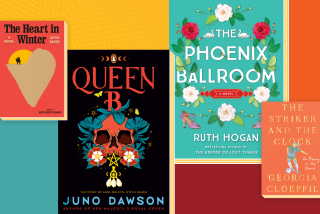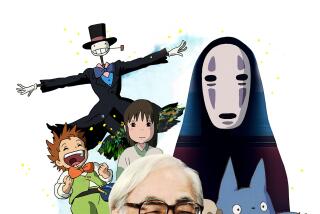Something ‘Wild’
An angry boy, talking monsters and a six-page, wordless wild rumpus: When Maurice Sendak sat down to write what would become “Where the Wild Things Are,” he didn’t quite know what he was getting into.
“I didn’t have a social conscience that I was doing anything different,” Sendak, 81, says from his Connecticut home. Mostly, the Brooklyn-born illustrator, then in his early 30s, was excited to tackle his first full picture book. “It was all my own and in full color. It’s hard to imagine now, with everyone doing them. But emancipating children was far from my mind.”
He certainly didn’t aim to rewrite the history of children’s literature. But those 10 sentences -- which tell of an unruly boy who is sent to bed without supper and sails to a magical land where he’s worshiped by an odd cast of animal-inspired creatures -- turned Sendak into more than just a famous writer.
“I became,” Sendak reflects, “a troublesome person: They expected something from me that would be trouble.”
The young Sendak also couldn’t have known that a shy kid growing up in New Jersey in the early ‘70s would be read the book by his mother and have his head turned around.
“As a kid, I felt like I could fall into those drawings, just disappear,” says director Spike Jonze, 39, whose long-awaited film adaptation of the storybook, scripted with novelist Dave Eggers, opens Friday. “I’ve just recently realized how powerful picture books are before you can read. There’s this entire world there.”
The production, which began with discussions between Sendak and Jonze in the mid-’90s, came close to disappearing altogether because of creative differences between director and studio. And though it could still be a Gen-X “Heaven’s Gate” with its cost overruns into the millions beyond its original $80-million budget, it has also -- thanks in part to a dynamic trailer -- become one of the most anticipated films of the year.
A mixed reaction to the film would mirror the book’s initial reception.
“Wild Things” became the kind of controversial work that draws denunciations -- child psychologist Bruno Bettelheim urged parents to keep away from it -- and helps transform its field.
But Sendak had advocates as well. Finally, they said, a writer who takes children seriously, who moves beyond a sentimentalized view of childhood. Today, he’s a hero to artists, including Meryl Streep and Tony Kushner, both of whom spoke at an 80th birthday celebration for Sendak last year, and he’s been called an important influence on writers as diverse as Chris Van Allsburg (“The Polar Express”), Brian Selznick (“The Invention of Hugo Cabret”) and Neil Gaiman.
Sendak’s next breakout, “In the Night Kitchen,” from 1970, included an anatomically correct boy hero and was banned by libraries while winning many of the field’s highest honors. (If it was known then -- as Sendak revealed last year -- that the author is gay, the controversy might have played out much more disastrously.)
“I don’t think it’s possible to overestimate Sendak’s influence on the 20th century,” says Susan Patron, the Los Angeles-based author of “Lucky Breaks” and a retired children’s librarian. “And not only in the field of children’s literature but in the broadest cultural context.”
Jonze has also made the 40-minute “Tell Them Anything You Want: A Portrait of Maurice Sendak,” which will air Wednesday on HBO. “How crazy is it that he invented those monsters?” Jonze asks. “Those creatures seem like they always existed. They seem like they were always there.”
--
Cultural revolution
Six years before “Wild Things,” Dr. Seuss’ similarly anarchic “The Cat in the Hat” was released; the year after Sendak’s book, a group of long-haired Englishmen crashed the U.S. pop music charts. The same forces that reshaped American culture in the postwar era were redrawing books for children as well.
Sendak, who spent much of the ‘50s illustrating the works of others, including the “Little Bear” series, describes typical postwar kids books as “training manuals. How to behave, what was acceptable and not acceptable. In other words, boring. And a complete misunderstanding of the nature of children.”
“Those years saw people new to college, new to the suburbs, new to the middle class,” says Seth Lerer, author of the National Book Critics Circle Award-winning “Children’s Literature: A Readers’ History From Aesop to Harry Potter.” Mainstream kids stories, then, helped orient these new arrivals, whether immigrants or veterans getting a boost from the GI Bill.
In one of the Little Golden Books popular at the time, “Scuffy the Tugboat” gets too big for his britches, ventures down a stream, then happily returns home. In another, things are put right by a resourceful lad dubbed “Doctor Dan, the Bandage Man.” Award-winning books recapped nursery rhymes and celebrated Tom Paine.
The blond, innocent kids cavorting alongside friendly animals in these books didn’t resemble the world Sendak knew. He looked to the European tradition, which he calls “more sophisticated, allowing for the complexity of childhood, which we didn’t.”
Sendak’s books differed even from the more serious writers of the ‘40s and ‘50s, such as Robert McCloskey and E.B. White, Lerer says. Their stories -- in such books as “Blueberries for Sal” and “Stuart Little,” respectively -- take place in cozy small towns or a wilderness very different from Sendak’s isle of grotesques. “Their characters escape into a pastoral, American Puritan wilderness,” Lerer says. McCloskey’s “Make Way for Ducklings” even finds a serene pastoral setting in the center of Boston.
Lerer, who was once called “wild thing” in Yiddish after he put a stickball through a Brooklyn neighbor’s window, thinks Sendak’s urban, ethnic roots are crucial to understanding his work. In contrast to a trip to seaside Maine, “The real place of safety is an escape to the apartment or the house for dinner.” Sendak, he says, is as Jewish a writer as Philip Roth.
Sendak himself, who describes his childhood as lonely and alienated, shadowed by poverty and haunted by the loss of relatives to the Nazis, concurs. “I was born and raised in Brooklyn, where things were difficult. You made your own way, and no one told you what was going on. But if you observe children, you see they are uncanny at figuring things out.”
--
Personalized stories
Jonze (born Adam Spiegel) says what drew him to Sendak did not have to do directly with the books’ resemblance to Kafka’s uncanny stories and Marc Chagall’s village-folkloric paintings.
Rather, the books hit him like a pop song written just for him. “I felt like I recognized the feeling,” he says. “As a kid, you gravitate to things that feel true. I didn’t know what it was about, but I knew what it meant.”
And Jonze, who broke into film by shooting skateboard videos and celebrated rock videos for Bjork, the Beastie Boys and Fatboy Slim, was drawn to Sendak’s free, wide-ranging visual imagination.
“Looking at ‘Night Kitchen’ and how Mickey falls through the floors and the ceilings -- that was so magical to me. It’s images like that that stuck in my imagination.”
Indeed, Sendak’s books weren’t just groundbreaking for their darker stories, their more torrid families, their less sentimentalized protagonists. It was also their innovative relationship between words and pictures.
In “Wild Things,” a single sentence can take pages to unfold, its meaning changing slightly with each image. And this book with numerous wordless pages ends with a half-sentence and no accompanying image. Sendak works similarly to the directors of the French New Wave, who used jump cuts and other techniques to dislocate their editing.
That visual richness and the complex, ambiguous world suggested by “Wild Things,” led Jonze to see an entire feature film in the book. (Some of Sendak’s stories, including “Where the Wild Things Are,” were adapted for animated shorts in the early ‘70s by Gene Deitch; that “Wild Things” comes in at around six minutes.)
“Are the monsters at Max’s beck and call?” Jonze asks. “Maybe not. Are they his friends? Are they inspiring? Are they going to eat him? There’s this menace to their eyes during the rumpus -- are they conspiring against him?”
This off-balance quality Jonze describes is certainly something he, Eggers and the film’s cast capture in the finished film. The movie begins with Max (played by Max Records) falling down a flight of stairs, to cacophonous sound design that follows through much of the film.
But early cuts were judged disturbing and abrupt, and the film Warner Bros. releases Friday may still have trouble connecting with children, as opposed to hip parents who consider themselves young at heart.
Sendak, who says the straightforward, Deitch-directed adaptations “don’t interest me,” expresses total faith in Jonze’s work. The two share a stubborn independence, he says, pointing out that he was about the same age when he began to work on his book as Jonze was when he began digging into the film.
“I’m most impressed with the freedom by which Spike said ‘no’ to me,” Sendak says. “I’m so pleased with his courage, his moodiness. Children’s movies bore me to death. With Spike, I found a genuine, fierce little artist. It’s not cute and cuddly! It’s a real movie.”
--
More to Read
Only good movies
Get the Indie Focus newsletter, Mark Olsen's weekly guide to the world of cinema.
You may occasionally receive promotional content from the Los Angeles Times.










